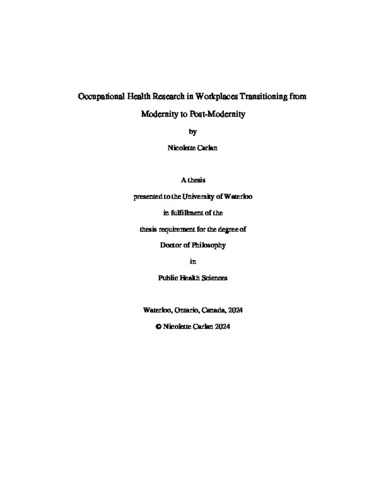| dc.description.abstract | Occupational health is a complex concept and the offspring of a marriage between law and science. The marriage is influenced by multiple extended families or networks, which act together and in opposition to create policy and modify work practices (Levenstein &Wooding 1999). The extended families now live in societies that are transitioning from modernity to postmodernity. For the purposes of this paper modernity describes the era when computers and data collection became readily available. Post-modernity describes the era when access to information and its accompanying power provided by that information became universally available because of access to the internet.
Research into occupational health has several goals including the identification of risk, the introduction of potential practices to reduce risk, and setting standards for which compensation is awarded. It is my hypothesis that the societal structure influences not only the subject of this research but also the methods of research, the conclusions of researchers and the potential impact of the research. This applied research programme brings together three studies, that focus on musculoskeletal disabilities (MSDs), that have all been conducted during the transitional period from modernity to post-modernity. Each study examines the creation, dissemination and implementation of knowledge - key products of research.
In this period of transition, the ability to conduct research is also in transition. Data collection is changing because there are fewer large workforces tied together with large insurance and corporate data bases. There is an increase in contingent work with workers changing work relationships on a regular basis. The economic impact of adverse health outcomes
is blurred because insurance coverage is no longer mandatory. In addition, the ability to transfer knowledge is more complex because compulsory training is less common.
The first study examines the development of knowledge about MSDs in a workplace that is in the initial stages of transition to post-modernity. The workplace is now primarily staffed by a part-time and transitory workforce, which was not fully engaged in health and safety activities. In this workplace, the union identified greater than expected MSDs but could only identify limited prevention activities. So, the full- time workers took the lead to build a body of knowledge that could be used to reduce injuries in the future. Participatory research methods gave voice to the workers’ experiential knowledge. That knowledge improved the tools promoted by academic researchers which ultimately resulted in a body of knowledge that has the potential to improve work practices. Unfortunately, at the beginning of the process we did not pay enough attention to one of the participating families, the employer, which did not participate or promote changes in work practices. As a result, we cannot report on any specific health and safety improvements. However, we are left with a body of knowledge and a group of workers with the skills to collect data and the ability to continue to promote safer working conditions.
The second study looks at the potential adverse health effects resulting from the introduction of new work processes in a non-traditional work setting. In this case the source of potential long-term injuries was identified by the workers. The workers together with an interdisciplinary research team documented adverse health findings. Because the workforce was contingent, the economic benefits which could be attributed to ergonomically beneficial tools were not obvious. As a consequence, the acquisition of better tools was not pursued by the employer/contractors. However, the research team was able to document developing adverse
health outcomes that could set the stage for compensation in the future and introduce prevention ideas to the workforce.
The final study examines the knowledge creation process in workplaces that are nearing the described characteristics of post-modernity. The stories of workplace parties identified the characteristics of successful innovators and welcoming non-traditional workplaces. A secondary analysis of qualitative interviews shed light on the common characteristics of innovators. That analysis also confirmed the importance of networks to disseminate knowledge with the aid of social capital owned by innovators. We were also able to document the benefit of fluid work demands which allotted time to make mistakes and pursue change.
These studies establish that it is necessary to not only to be guided by established research methods but to also be cognizant of the context in which the research is conducted. With modified research methods, the teams were able to collaborate with transitioning workforces to create knowledge about health outcomes, disseminate that knowledge, and set the stage for the application of that knowledge. These studies illustrate that research which can contribute to safer workplaces must accommodate the societal boundaries in which it is conducted. | en |

